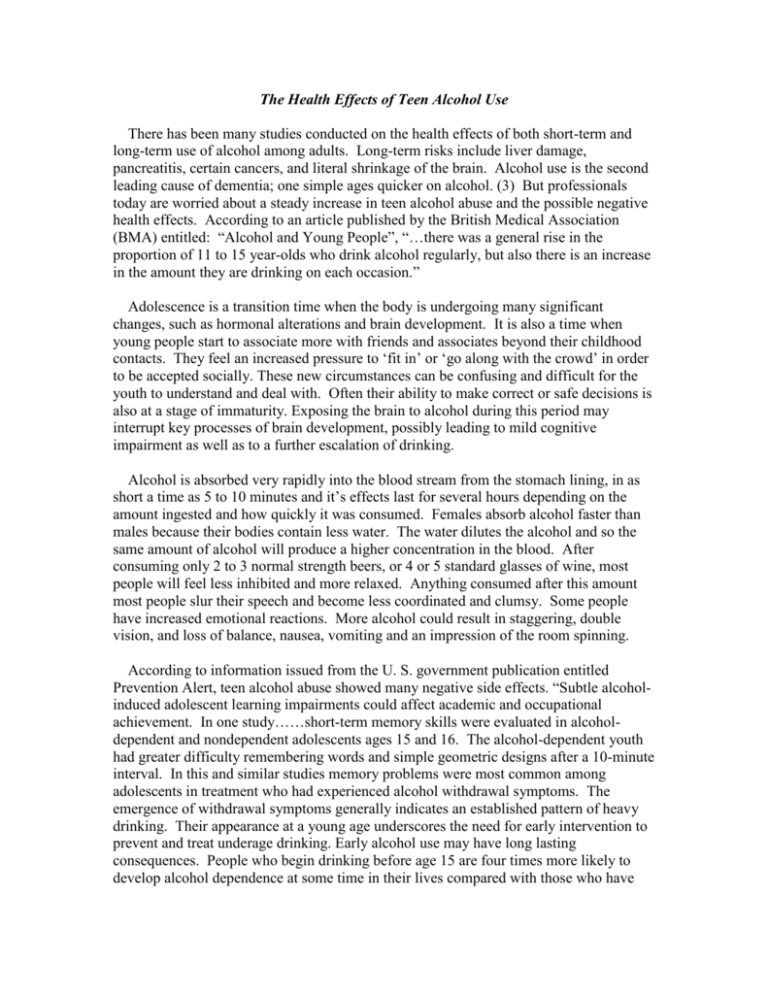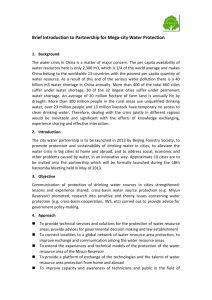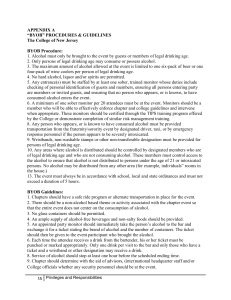
The Health Effects of Teen Alcohol Use
There has been many studies conducted on the health effects of both short-term and
long-term use of alcohol among adults. Long-term risks include liver damage,
pancreatitis, certain cancers, and literal shrinkage of the brain. Alcohol use is the second
leading cause of dementia; one simple ages quicker on alcohol. (3) But professionals
today are worried about a steady increase in teen alcohol abuse and the possible negative
health effects. According to an article published by the British Medical Association
(BMA) entitled: “Alcohol and Young People”, “…there was a general rise in the
proportion of 11 to 15 year-olds who drink alcohol regularly, but also there is an increase
in the amount they are drinking on each occasion.”
Adolescence is a transition time when the body is undergoing many significant
changes, such as hormonal alterations and brain development. It is also a time when
young people start to associate more with friends and associates beyond their childhood
contacts. They feel an increased pressure to ‘fit in’ or ‘go along with the crowd’ in order
to be accepted socially. These new circumstances can be confusing and difficult for the
youth to understand and deal with. Often their ability to make correct or safe decisions is
also at a stage of immaturity. Exposing the brain to alcohol during this period may
interrupt key processes of brain development, possibly leading to mild cognitive
impairment as well as to a further escalation of drinking.
Alcohol is absorbed very rapidly into the blood stream from the stomach lining, in as
short a time as 5 to 10 minutes and it’s effects last for several hours depending on the
amount ingested and how quickly it was consumed. Females absorb alcohol faster than
males because their bodies contain less water. The water dilutes the alcohol and so the
same amount of alcohol will produce a higher concentration in the blood. After
consuming only 2 to 3 normal strength beers, or 4 or 5 standard glasses of wine, most
people will feel less inhibited and more relaxed. Anything consumed after this amount
most people slur their speech and become less coordinated and clumsy. Some people
have increased emotional reactions. More alcohol could result in staggering, double
vision, and loss of balance, nausea, vomiting and an impression of the room spinning.
According to information issued from the U. S. government publication entitled
Prevention Alert, teen alcohol abuse showed many negative side effects. “Subtle alcoholinduced adolescent learning impairments could affect academic and occupational
achievement. In one study……short-term memory skills were evaluated in alcoholdependent and nondependent adolescents ages 15 and 16. The alcohol-dependent youth
had greater difficulty remembering words and simple geometric designs after a 10-minute
interval. In this and similar studies memory problems were most common among
adolescents in treatment who had experienced alcohol withdrawal symptoms. The
emergence of withdrawal symptoms generally indicates an established pattern of heavy
drinking. Their appearance at a young age underscores the need for early intervention to
prevent and treat underage drinking. Early alcohol use may have long lasting
consequences. People who begin drinking before age 15 are four times more likely to
develop alcohol dependence at some time in their lives compared with those who have
their first drink at age 20 or older. It is not clear whether starting to drink at an early age
actually causes alcoholism. Environmental factors may also be involved, especially in
alcoholic families, where children may start drinking earlier because of easier access to
alcohol in the home, family acceptance of drinking and lack of parental monitoring.
Aside from the fact that underage drinking is illegal, it poses a high risk to both the
individual and society. We will discuss some of the consequences of teen alcohol abuse.
Drinking and Driving
Motor vehicle crashes are the leading cause of death among youth ages 15 to 20. The
rate of fatal crashes among alcohol-involved drivers between 16 and 20 years old is more
than twice the rate for alcohol-involved drivers 21 and older.
Suicide
Alcohol use interacts with conditions such as depression and stress to contribute to
suicide, the third leading cause of death among people between the ages of 14 and 25. In
one study, 37 percent of eighth grade females who drank heavily reported attempting
suicide, compared with 11 percent who did not drink.
Sexual Assault
Sexual assault, including rape, occurs most commonly among women in late adolescence
and early adulthood, usually within the context of a date. In one survey, approximately
10 percent of female high school students reported having been raped. Research suggests
that alcohol use by the offender, the victim or both, increase the likelihood of sexual
assault by a male acquaintance.
High-Risk Sex
Research has associated adolescent alcohol use with high-risk sex, for instance,
multiple partners or unprotected sex. The consequences of high-risk sex also are
common in this age group, particularly unwanted pregnancy and sexually transmitted
diseases, including HIV/AIDS. According to a recent study, the link between high-risk
sex and drinking is affected by the quantity of alcohol consumed. The probability of
sexual intercourse is increased by drinking amounts of alcohol sufficient to impair
judgment, but decreased by drinking heavier amounts that result in feelings of nausea,
passing out, or mental confusion. Binge Drinking. Though most college drinkers
would deny it, young people do die solely from drinking. In 1995, 318 people ages 15 to
24 died from alcohol poisoning alone, man of them after a night binge at college. At the
University of Virginia, a tradition that has seniors drinking a fifth of hard liquor at the
final game of the football season (so-called “Fourth-year Fifth”) has killed 18 students
since 1990. (3)
Works Cited
British Medical Association BMA, article Alcohol and Young People, Health 1999
(2) Prevention Alert, Vol. 5 Number 6 May 10, 2002,
ncadi.samhsa.gov/govpubs/prevalert/v5/2.aspx
(3) Author: Kattie Payne, RN, PhD Last updated September 9, 2002, copyright 19952004, Healthwise, Incorporated, P. O. Box 1989, Boise, ID 83701.
http://www.teendrugabuse.us/teensandalcohol.html







